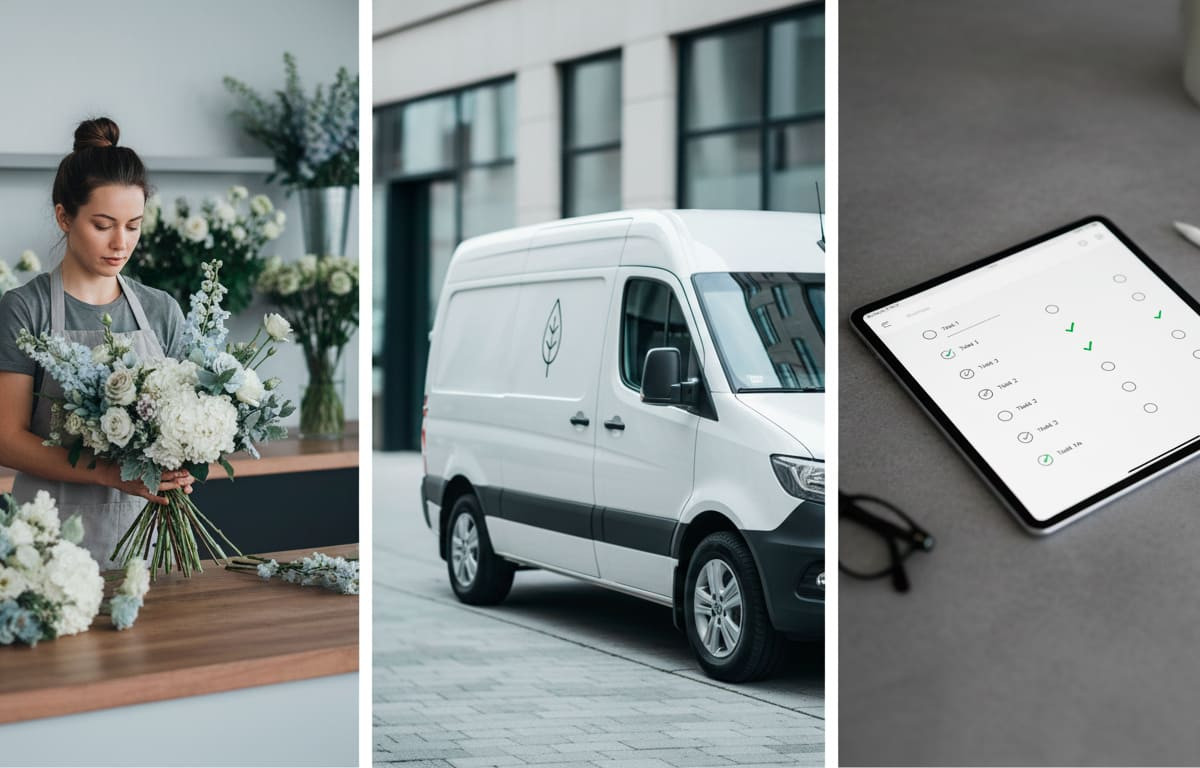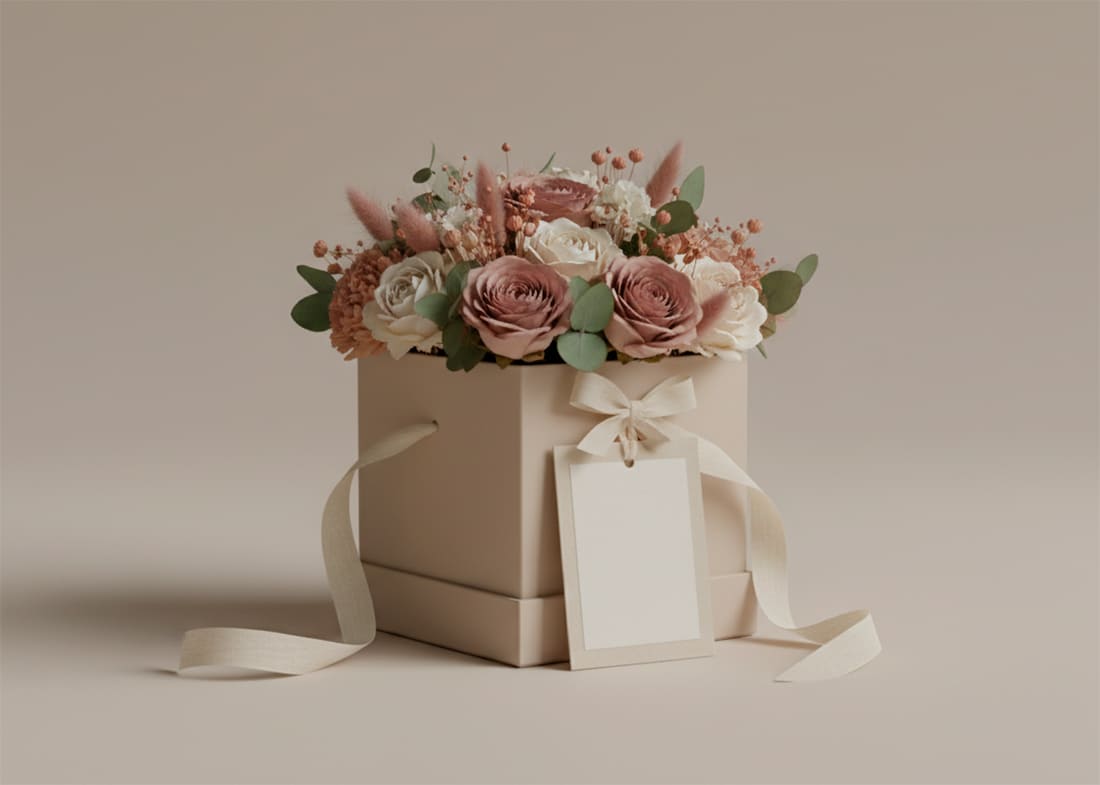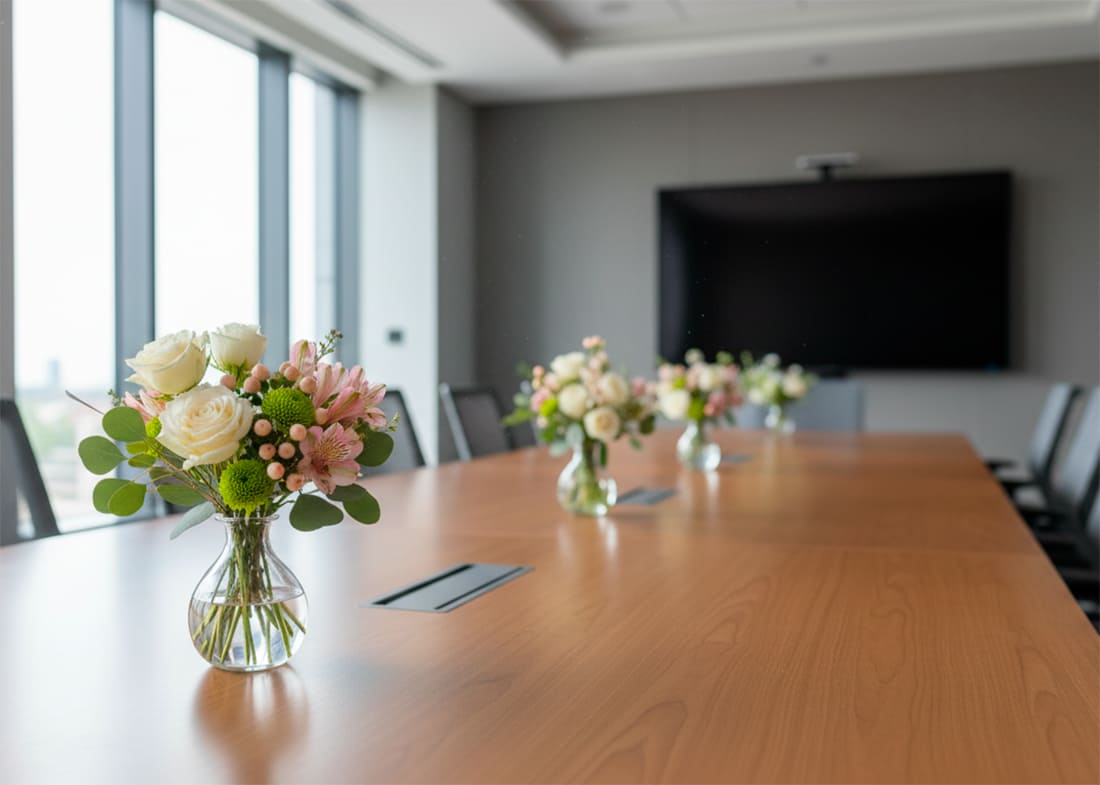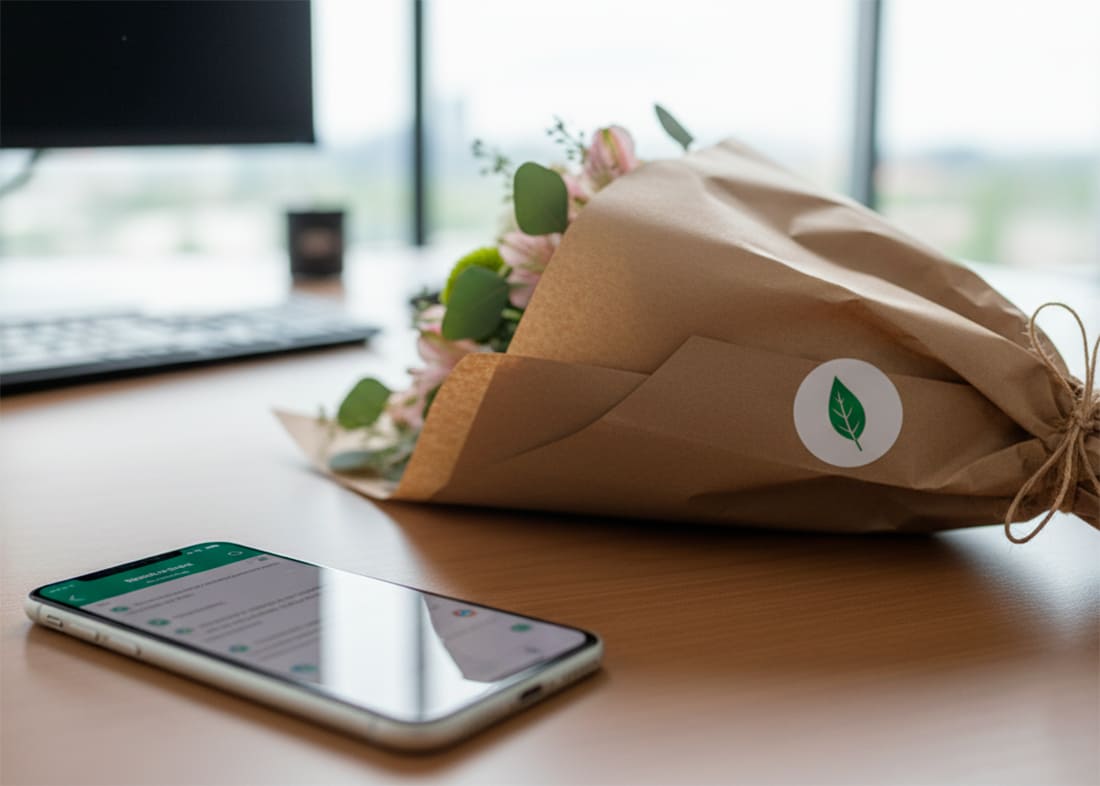
How a flower shop can build corporate sales
Where to Start and Who You’re Selling To
Corporate sales aren’t about “a little bit for everyone.” They’re about precision targeting. First, decide which companies you want to work with: offices that need regular arrangements, event agencies ordering in bulk, hotels and restaurants with specific style requirements, or real estate developers with showrooms. Each segment has its own purchasing logic and approval timelines.
Set a clear message: “We sell consistency and reliable service — not just bouquets.” It may sound simple, but that’s exactly what purchasing managers and office administrators are looking for. Help them feel at ease: show that you have delivery schedules, clear flower substitutions, photo reports, and clean documentation. That’s where trust is born — and only then comes the “wow effect.”
How to Identify the Profile of Your Ideal Corporate Client
Start with three traits. First — regularity. Look for businesses where flowers are part of the routine: reception, meeting rooms, gifts for employees and partners. Second — one or two offices within your delivery radius; multiple locations require a separate setup. Third — a clear budget for “office decoration” or “corporate gifts.”
Add more context: industries where image matters (IT, finance, real estate), team size (50–70 people already means a steady flow of greetings), and the presence of events. And here’s a tip: sometimes your “ideal client” isn’t a giant, but a mid-sized company nearby — less traffic, fewer risks, better margins.
Who Makes Flower-Related Decisions and How to Reach Them
There are several entry points. Procurement handles procedures and pricing; they care about lead times, transparent catalog items, and reliable delivery. Office managers and admin teams evaluate quality on the ground — they sign delivery notes and send the first message if something’s wrong. HR and PR oversee greetings and the brand tone of cards. Finance processes the payments.
How do you approach them without a cold call? Simple route: a short email to the company’s general address + a quick call to the front desk with one question (“Who’s responsible for reception flowers or employee bouquets?”). Next — a one-page mini catalog and a pilot offer for 2–4 weeks. No fluff, just facts: what, when, how much, and what replacements look like.
How to Create a Clear B2B Offer
Businesses value clarity. Skip “inspired” language — add structure. Describe three things: what exactly you supply, how often, and under what conditions quality is maintained. Speak plainly and back it up with real photos of your arrangements in office settings (neutral background, top view, ruler in frame — yes, that helps).
Formulate promises that can be verified: “Delivery by 10:00 ±30 minutes,” “Average vase life with basic care — at least X days,” “Replacement on the same day in case of damage.” Sounds dry? Maybe — but that’s how you end up with contracts that don’t need extra edits.
Service Packages and Options (Reception, Greetings, Events)

Think in packages, like set menus in a café. For receptions — regular arrangements in three sizes (S/M/L) with a fixed palette matching brand colors. For greetings — a “short line” of bouquets and boxes: standard, premium, VIP; each with a neutral card and space for personal notes. For events — quick solutions: table centerpieces, photo zone, boutonnieres, one or two decorative zones.
Add “service modules”: urgent replacements, extended delivery windows, storage for branded ribbons and cards at your warehouse, and simple in-office care (weekly water change and stem trimming). Offices love these details — they remove small headaches and elevate you into the “reliable supplier” category.
How to Describe Quality, Timelines, and What’s Included in the Price
Break pricing into clear components: flowers, assembly, packaging, delivery, VAT. Note what’s always included (care card, basic vase upon request, pre-shipment photo) and where extra charges apply (custom packaging, night delivery, restricted-area passes). This eliminates 80% of future questions.
As for timelines and quality — keep it short and clear: “We deliver on weekdays from 8:00 to 20:00; time slot — 60 minutes; truck temperature — +5…+8 °C; replacements same day in case of overheating or damage.” And one small touch: “Height tolerance ±10%, shade variations within agreed palette.” Sounds strict, but leaves no room for disputes.
Don’t forget SEO: use natural website phrases like “corporate flower clients,” “office flower delivery,” “reception floral service,” “corporate flower gifts,” “B2B flower shop.” They read naturally for people and help search engines understand your niche.
How to Calculate Pricing and Payment Terms
Prices should be transparent and predictable. Start with cost structure: flower purchase + supplies + assembly + delivery + taxes. Add a small “cushion” for losses and seasonal fluctuations — a modest percentage that saves your margin when weather or logistics surprise you. Test final pricing on real routes: two morning addresses and one midday — logistics often cost more than expected.
Offer simple payment options: prepayment for one-time orders, postpayment (15–30 days) for regular clients, and credit limits for trusted ones. Define clear price-freeze terms for 3–6 months; after that, index gradually with advance notice. No magic — just transparent rules that work for both you and the client’s accounting team.
Fixed Catalog, Volume Discounts, and Seasonal Coefficients — What to Choose
A fixed catalog acts as an anchor: clients see consistent items with price ranges. Add tiered volume discounts — not “20% off for everyone,” but reasonable thresholds (e.g., from X orders per month or Y addresses per delivery wave). Fair and easy to explain.
Seasonal coefficients are essential during peak periods when the market is “on fire” (Valentine’s Day, Women’s Day, New Year). Communicate them in advance and suggest flower alternatives. Yes, they may sound tough, but that’s how you maintain quality during shortage days. Better to be transparent than to cut corners and fail expectations.
Prepayment, Postpayment, and Limits — Minimizing Risks on Both Sides
Prepayment protects you at the start and simplifies cancellations. Postpayment signals trust — but it should be earned through a successful pilot and accurate paperwork. A credit limit is the golden mean: the client gets flexibility, you get risk control.
Set a few “safety” details: invoice timing, acceptance confirmation, defect criteria, and replacement deadlines. Small rules save big nerves — for both sides.
Where to Find Corporate Clients
Look where people need to “decorate the office or congratulate the team quickly and painlessly.” Business centers, coworking spaces, local admin chats, city business communities, industry events. Simple geography works too: companies within a 20–30 minute radius from your workshop are top priority.
Don’t overlook those “in charge of details”: office managers, assistants, event coordinators. They don’t sign contracts but influence choices. A few successful pilots — and you’re already “the florist” for an entire business district.
Cold Emails and Calls, LinkedIn/HH, Local Networks and Events
Cold emails should be short and human. One screen: who you are, what exactly you do for offices, one real example with a photo, and a clear next step — “two-week pilot, three deliveries, fixed price.” The call shouldn’t sound like “we sell flowers,” but rather “who handles reception decor and employee greetings?”
LinkedIn and HH (profiles of office managers, HR, admins) are another entry. Add a short case post: “How we decorated a 15-table conference in 48 hours.” And don’t skip local admin breakfasts or business center manager meetups — more deals happen there than over email.
How to Build a Contact Database and Keep Negotiations Organized
Create a simple database: company name, address(es), industry, key contacts, notes on taste and budget, status (new, pilot, price sent, contract, active). You don’t need a complex CRM — a spreadsheet works fine for the first few months if you keep it tidy.
Record all agreements: favorite bouquets, who accepts deliveries, preferred days and times, key holidays. Each note removes one potential mistake. And yes, set reminders: no messages on Friday, and on Monday — only after 11 a.m. Small details, big trust.
How to Conduct the First Meeting and Brief
The first meeting isn’t about “look how creative we are,” it’s about “how can we make your life easier.” Ask for 20–30 minutes, arrive on time, bring a mini catalog and one or two sample arrangements (compact, office-style). A few questions — and you’ll already see the picture: number of locations, replacement frequency, who approves cards, and any brand restrictions.
Write down the answers, don’t rely on memory. End with a clear next step: “Shall we start a two-week pilot? Three deliveries, fixed price, replacements agreed in advance.”
What Questions to Ask to Understand Needs and Budget
Ask the basics: where the flowers will be placed, replacement frequency, preferred height, brand palette shades, any allergies or plant restrictions. Discuss holidays and regular occasions — birthdays, welcome kits, partner visits.
Money talk — no dance around it. “What’s your monthly budget range?” “Do you prefer fixed catalog prices or flexible ranges?” — direct questions don’t offend; they save time.
What Materials to Bring: Mini Catalog, Samples, Short Brief
The mini catalog — one page: three reception sizes, three greeting bouquets, base prices, palettes, timelines. Samples — photos showing “how it looks in the office” (not staged, natural light, top view and full reception shot).
The short brief — half a page: delivery frequency, preferred time slots, acceptance contact, replacement rules, and a quick care reminder. It may look modest, but it’s clear: fewer words, more order.
How to Prepare a Commercial Offer That Gets Approved Quickly
The commercial offer has to answer three simple questions: what exactly you supply, by what time you deliver, and how much it costs. One file, one table, and one clear photo for each block. At the end — a short “how it works” section: delivery windows, receiving contact, replacement rules, and document flow. Easy to read, easy to approve.
Offer Structure: Options, Pricing, Timing, Sample Delivery
Start with a half-page cover: company name, validity period for pricing, and contact person. Then break it into three sections:
- Reception. Sizes S/M/L, palettes, height, price per delivery, frequency.
- Greetings. Three sets — standard, premium, VIP; cards, delivery to individual addresses.
- Events. Table arrangements, welcome area, boutonnieres; base packages for 20/50/100 guests.
Next to each table — one real “in the office” photo. Underneath — timing: “weekday delivery 8:00–20:00, 60-minute window; urgent delivery on request.” Add a small “sample delivery” block: address, timestamp, two acceptance photos, name of the receiving person. The client sees the process, not just the bouquets.
How to Pre-Approve Acceptable Substitutions by Flowers and Varieties
Create a mini table: “if unavailable → we replace with.” For example: powder rose → cream rose; white lisianthus → alternative in the same tone. Write down limits for height and fullness, plus a no-go list (strong fragrance, pollen, thorns).
Lock in palettes. Three swatches — “warm,” “cool,” “neutral” — with color codes. This keeps the look consistent without tying you to a specific variety. And yes, add the phrase “palette first, then variety” — it saves you on peak dates.
How to Launch a Pilot and Turn It Into a Long-Term Contract

A pilot tests more than flowers — it tests your promises. Agree on a short period: two weeks, three deliveries, fixed price. Assign a point of contact on both sides and one shared communication channel.
Ask for honest feedback after every delivery. Don’t be afraid of small adjustments — they speed up the path to contract. The goal is simple: prove consistency and remove the office’s anxiety.
What to Check During the Pilot: Timing, Appearance, Vase Life, Feedback
- Timing. On time, not “when we manage.”
- Appearance. Correct height, fullness, palette; clean packaging.
- Vase life. Photos on day 1 and day 3; a short note on how the arrangement looks.
- Feedback. Who receives, who sends comments, how fast you respond.
Build a one-page mini report. A couple of before/after photos, actual delivery times, comments, and your response. This report goes straight to management — and the arguments in your favor are already prepared.
How to Turn Pilot Results Into Clear Service Rules
Move everything you’ve agreed on into two documents: the “order sheet” and the “delivery sheet.” The first includes sizes, palettes, frequency, points of contact, replacement rules. The second includes addresses, timing, access passes, receiving contact, photo format.
Add two appendices: an acceptance checklist and a short care guide. Now the client has a clear “manual,” and you have a document to reference during peak days.
How to Organize Production and Delivery for Corporate Orders
Assembly happens in a cool area; packaging is clean, no heavy fragrances, no branding (if the client’s policy is strict). Routes should be short, no zigzags. For multi-address routes, plan delivery waves and put VIP stops first.
Give the driver an insulated box / thermal container, a contact list for each address, and one rule: “photo before dispatch — photo at handover.” It’s simple and it never fails.
How to Maintain Cooling, Packaging, and Gentle Transport
Keep vehicle temperature around +5…+8 °C, avoid storing flowers next to fruit or strong odors. Use breathable packaging — no “greenhouse effect.” Secure arrangements in transit with soft restraints, no tight crates.
Before leaving, run a quick checklist: fresh cut, clean water/nutrient solution, intact ribbon, neat label. One minute now saves an hour of back-and-forth later.
How to Handle Handover on Site
On location — one simple procedure. The receiving person checks the arrangement on three points: integrity, height, palette. The courier takes a top-view photo and a full shot on the counter/table, notes the time, and writes down the receiver’s name.
If there’s a comment — no arguing. Note it in the chat, trigger a replacement. The faster and calmer the handover, the stronger the trust. And yes, these same photos go into your monthly report — it makes payment approval easier for accounting and management.
How to Survive Peak Dates Without Breaking Down
Peaks aren’t a surprise, they’re a schedule. Put key dates on a calendar: Valentine’s Day, Men’s Day, International Women’s Day, New Year, graduations, and major local forums. For each period, plan volume, staffing, and vehicles in advance. Sounds strict — but it saves nerves.
The rule is simple: capacity first, sales second. Calculate how much you can realistically assemble and deliver in one day, lock those slots, and only take orders within that limit. That’s how corporate flower delivery stays clean even when the phone is melting.
Pre-Orders, Reserves, and Variety Alternatives
Pre-orders are your anchor. Three to four weeks in advance, collect requests, confirm palettes, lock in dates and time windows. On purchasing, keep reserve stock of the most requested items and prepare “if not available → replace with…” pairs in the same color range. It keeps the client calm and makes your job easier.
Talk through seasonal coefficients and payment timing in advance; a clear conversation early saves an hour of explanations on the critical day. And yes, list the alternative varieties right in the offer — don’t try to be a hero during shortage.
Routes and Delivery Timing for VIP and Multi-Address Orders
On peak days, organize delivery in waves: early morning for VIP stops and addresses requiring passes, then continue district by district. Divide multi-address routes into small groups of 5–7 stops; one courier per group, no zigzags.
Set short arrival windows — 60–90 minutes. For key clients, keep a “buffer”: a bit of time margin and one backup vehicle. A little breathing room in the schedule means you won’t be late, even if the elevator decides to take a break.
How to Draft Contracts and Paperwork Without Delays
The fewer “unique” approvals, the faster the payments. Use a master agreement with living appendices: catalog, delivery schedule, replacement rules, and document templates. Keep all debatable points inside the contract, not in email threads.
Another trick: include a one-page “how we work” sheet. Outline roles, contacts, invoice timing, and who confirms delivery. Accounting appreciates it — and you get fewer follow-ups.
What to Include in the Master Agreement and Appendices
The contract itself should cover: subject (floral arrangements and office flower delivery), terms, responsibilities, base prices, peak indexation grid, and replacement policy for damaged goods. Appendices should include: catalog with item codes and sizes, palettes, acceptance checklist, and a monthly report template.
Add a delivery map specifying “delivery time windows” for each address, list of contacts, and access requirements. The result is concise yet comprehensive documentation — exactly what procurement teams value.
Electronic Document Flow and Status Tracking
E-document flow saves days. Define clearly: when invoices are issued, who confirms documents, and the monthly closing deadline. In the chat, use three statuses per delivery: “on the way,” “delivered,” “accepted.”
The courier sends photo proof to the same channel. It takes a minute but speeds up payment and resolves 90% of disputes.
How to Maintain Quality and Demonstrate Results

Quality isn’t abstract — it’s a rhythm: consistent timing, neat appearance, and transparent reporting. Agreed palette? Stick to it. Promised same-day replacement? Deliver without debate.
Show the process. Send a short weekly update and a monthly summary with numbers. The client sees not just pretty pictures, but discipline — and that’s more convincing than any presentation.
Weekly and Monthly Reports on Timing and Replacements
Weekly report — half a page: number of deliveries, timing deviations, number of replacements and reasons. Monthly report — one-screen table: actual arrival windows, “on time” / “delayed by X minutes,” replacement rate, and photos of a few typical deliveries (to reception or meeting room — depending on client format).
Add short notes: “improvements made” and “next month’s plan” (for example, a new summer palette). Both office managers and executives appreciate this kind of summary.
How to Handle Complaints and Restore Trust Quickly
The three-step rule. First — acknowledge and document the issue (photo, time, address). Second — offer a concrete solution: same-day replacement, refund, or discount on the next delivery. Third — brief, calm debrief: what went wrong and how it was fixed.
Don’t argue about taste, stick to facts. Height, palette, cleanliness of packaging — everything can be measured and photographed. Calm tone + quick replacement = loyalty that survives any mishap.
How to Grow the Account After Launch
Stable deliveries are the foundation; growth comes from steady communication. Schedule short quarterly meetings: 30 minutes, three slides, one page of metrics. Show trends in timing, replacements, photos of two standard deliveries, and a list of seasonal ideas. It’s down-to-earth — and it works.
Keep an “opportunity map”: which departments aren’t yet covered, where regular meetings happen, where mini-arrangements fit. Small steps — new zones, new occasions, new addresses — and your share of the budget grows naturally.
Regular Meetings, Seasonal Ideas, and Cross-Sales
Simple plan: end of month — a short email update; once per quarter — a meeting. Suggest seasonal palettes, mini “summer/winter” lines, collections for anniversaries or welcome kits. Don’t push — offer as a natural addition to the existing package.
Cross-sales should feel effortless: “We have a matching set for the reception or waiting area — a pair of mini vases for meeting rooms”; “Birthday season coming up? We’ve prepared cards and neutral messages.” The client hears care, not a sales pitch.
How to Offer Gift Sets Discreetly Without Violating Company Policy
Every company has its own gift policy. Ask about budget limits and restrictions on branding, fragrances, or alcohol. Suggest three price levels and understated packaging — no “loud” design. A neutral message card and branded ribbon — that’s all.
The simple trick: position gifts as “service items.” There’s an occasion — there’s a standard set. Less luxury, more respect. That keeps HR and legal departments comfortable.
How to Manage Risks and Inventory
Risks prefer silence — that’s why it’s best to write them down. Make a list of “what could go wrong”: delivery delay, traffic jam, temperature spike, sudden variety shortage. Next to each — your plan B: backup supplier, spare vehicle, pre-approved alternatives, extra packaging stock.
Keep a short incident log: date, cause, action taken, conclusion. It fits on one sheet but serves you the whole season.
Dependency on One Supplier, Force Majeure, and Plan B
Working with a single supplier is convenient — until something goes wrong. Always have at least two partners, and for the most popular flowers, keep an alternative variety ready. The same applies to delivery: reserve an extra slot “just in case” and have the driver’s number who can step in. It may sound old-fashioned, but it works on the busiest days.
Unexpected things happen. Write right away, without long explanations: what happened, when you’ll realistically deliver, and what you can offer instead. Honesty and speed are valued far more than polished excuses.
How to Calculate Minimum Stock Without Overwriting
Use a simple formula: average daily demand × replenishment time + a small “buffer” for fluctuations. Fast-moving varieties go to the top of the list, delicate ones — by preorder only. Evening photo inventory and a quick morning check eliminate surprises.
Follow the “first in, first out” rule. Earlier batches go to assembly first; freshness doesn’t wander around the warehouse, waste drops, and margins stay stable.
What Helps You Stand Out Among Competitors
Honest punctuality and calm communication make you stand out more than rare flowers. Add tidy “in-office” photos, concise reports, and polite reminders. People search for “reliable corporate flower delivery” — give them exactly that feeling.
Another touch — “small services” that no one promises but everyone appreciates: neat same-day replacements, proper handling of access passes, quiet setups without mess on site. These details get noticed.
Subtle Branding, Signature Cards, and Neutral Texts
Show your brand subtly: a narrow ribbon in a calm tone, a small tag on the back, a palette that matches the company’s style. No bold logos or harsh contrasts — the arrangement remains the focus.
Cards should use universal wording, space for personal notes, and a clean, readable font. This approach fits the interior and internal company rules; it looks professional and appropriate in receptions and meeting rooms.
Small Office Services: Water Change, Trimming, and Reminders
Add a “quick care” service: scheduled water replacement and stem trimming. The courier is already there — five minutes of work adds two or three extra days of vase life.
Set chat reminders: “Water change at reception today — is now convenient?” One short question, and the office won’t forget. It seems minor, but clients remember these small touches.
Common Mistakes and How to Avoid Them
Mistakes in B2B flower sales are usually practical, not theoretical. Teams stumble over excessive creativity, vague promises, and logistics without time buffers. Below are short anti-examples and working replacements.
Overly “Creative” Offers, Unproven Promises, Weak Logistics
A 15-slide proposal with metaphors looks impressive but slows approval. What you need is one file and one table: packages, prices, delivery windows, and real delivery photos. No “like in Paris” claims — only what can be repeated every week without surprises.
Promises without proof undermine trust. Instead of “always on time,” use facts: arrival window 60–90 minutes, same-day replacement for damaged items. Attach two case photos and a short report. The process is visible — no room for argument.
Logistics without a buffer is a common failure. The fix is simple: early VIP addresses, district-based “comb” routing, and one spare vehicle on peak days. A route without zigzags, a checklist, and a thermal box — and everything arrives calmly.
Nontransparent Pricing and Long Approvals — How to Simplify
“Price on request” makes procurement nervous. Instead, list it all upfront: flowers, assembly, packaging, delivery, taxes. Add a separate line for urgent orders and access passes, plus the price validity period and soft seasonal indexation.
Approvals drag when too many “unique” conditions are hidden in emails. Move all rules to appendices: palettes, allowed substitutions, acceptance checklist, report format. Then the manager doesn’t search for “that one email” — they open the right section and tick a box.
Useful Appendices
Appendices save hours and remove extra questions. Below are short templates you can insert into a contract or send as standalone files.
Brief and Pilot Checklist for Corporate Clients
Brief (1 page):
- Addresses and receiving contact; weekday and holiday delivery windows.
- Placement zones: reception, meeting rooms, office.
- Form factor: S/M/L, height, preferred palette; banned scents and species.
- Delivery frequency and key quarterly dates.
- Documents: format, timing, responsible persons.
Pilot (2 weeks, 3 deliveries):
- Fixed price for the period, photo before dispatch, photo at handover.
- Mini metrics: on-time arrival, palette match, appearance on day 1 and day 3.
- Feedback channel for remarks, response time within 2 hours.
- Final one-page report: facts, comments, adjustments made.
Templates for Commercial Offer, Catalog, and Replacement Rules
Commercial Offer (1–2 pages):
- Package table: reception S/M/L; greetings standard/premium/VIP; events for 20/50/100 guests.
- “All-inclusive” prices with optional add-on lines.
- Timing and delivery window, sample delivery with photo and receiver’s signature.
Catalog (short):
- Item code, height, palette, “in-office” photo.
- Notes: vase upon request, care card, neutral greeting card.
Replacement Rules (mini-table):
- “No powder rose → cream rose in the same palette.”
- “No white lisianthus → alternative variety without strong scent.”
- Tolerances: height ±10%, shade within agreed range.
- Exclusions: thorns, pollen, strong fragrance — excluded by default.











